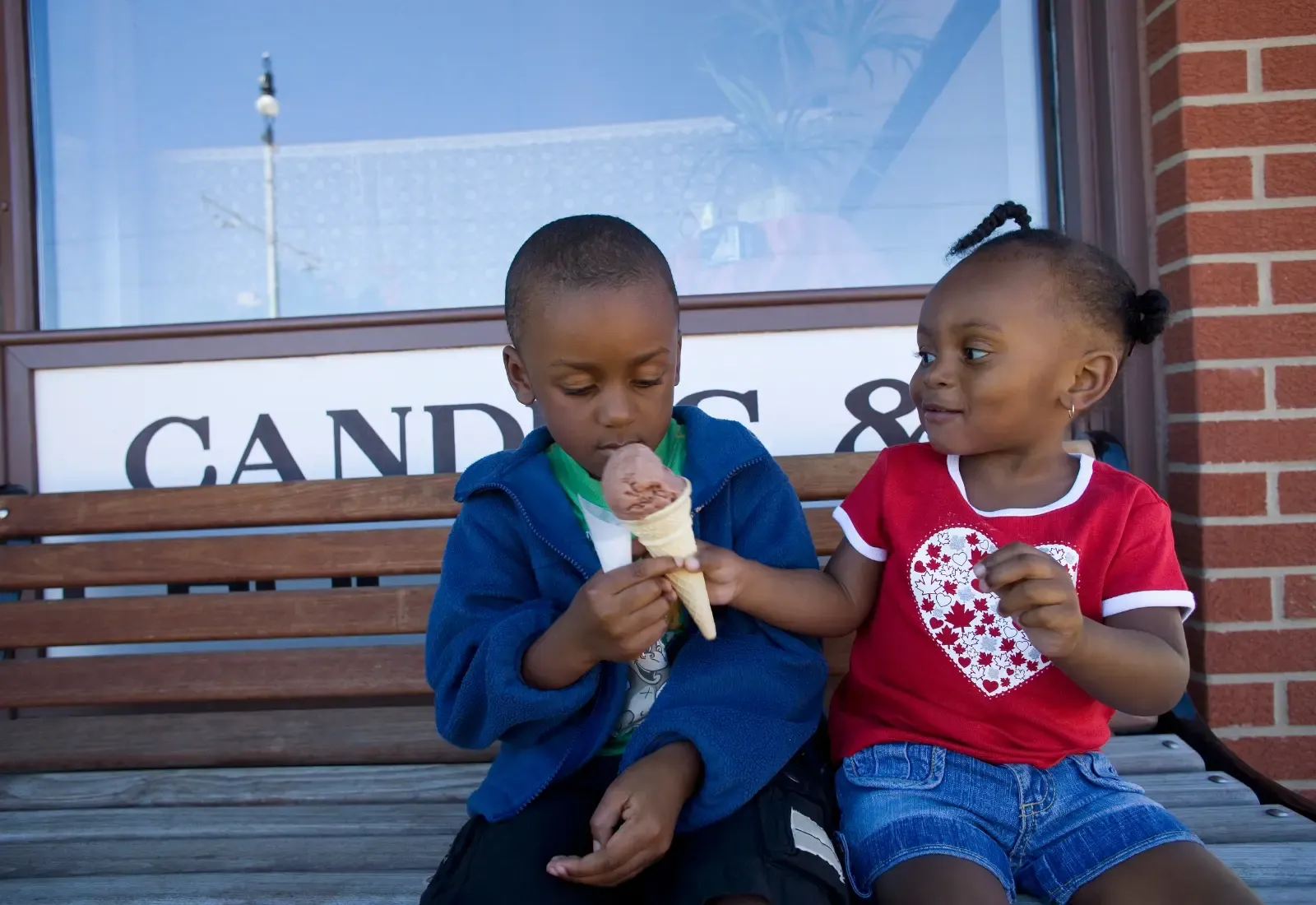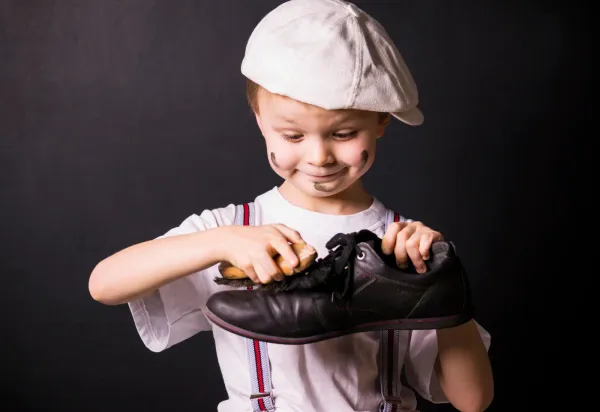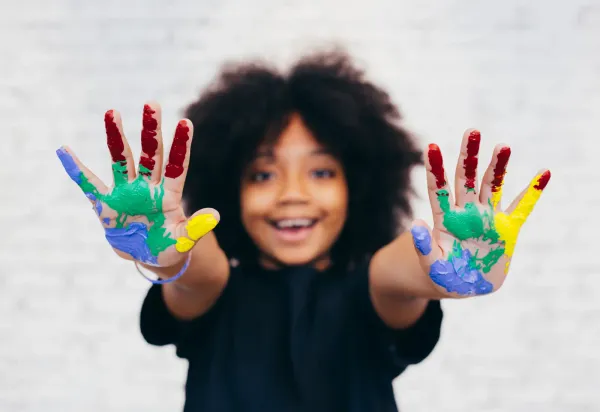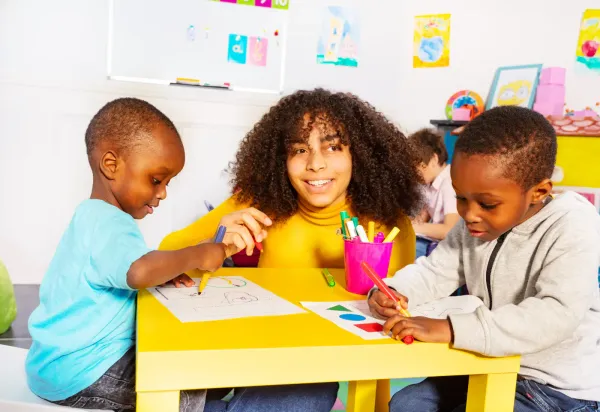I loved first grade.
More to the point, I adored my first-grade teacher, Mrs. Hernandez.
She was kind and helpful. She had a way of making everything fun.
She used a story game to help us learn to write. She gave us simple prompts; we then had to draw a picture of the word or idea and write a single sentence that told her about our picture.
I loved it.
But I loved it more because when she went around the room checking our work, she said positive, encouraging things.
She gave constructive feedback.
It made me want to improve.
I felt how much she cared. I could see the enthusiasm in her eyes when she looked at my work.
I wrote and drew and wrote some more. I was inspired to try harder and do more.
I didn’t even notice that I was learning. I was happily connecting. And feeling elated that she liked my ideas.
She put me, and I’m sure every other student, at the heart of her plan. She focused on our development as people, and her relationship with us.
What child-centered learning looks like
Mrs. Hernandez was ahead of her time; in 1973, most classrooms had kids sitting at desks in rows and doing what they were told, following directions, not talking, and not engaging.
She not only created a kid-friendly space — using small tables in groups instead of desks, creating a reading corner, encouraging us to express our ideas using colored pencils and crayons, doing projects with us, and encouraging discussions— she focused on us as people.
I learned loads, mainly because I was happy and felt supported.
I had many compassionate teachers throughout grade school. I was fortunate.
But I also experienced unsupportive learning environments where I didn’t feel seen as a person first… and didn’t learn.
When learning makes no sense
Maybe a teacher says and does all the right things, but prioritizes their educational goals for their classroom over their students — as people.
No matter how well organized the material, and how clear the lesson is, when kids don’t feel seen as people, what they’re being asked to learn doesn’t make sense.
Kids tune out and feel disconnected.
Even as adults, we have an easier time focusing and learning something when we have a positive feeling about the person teaching us.
We put our trust in people we connect to, and have an easier time learning because the environment feels supportive.
When learning is joyful
Babies and toddlers learn by engaging with their parents, the people in their world, and their surroundings.
They watch their parents’ faces, looking for encouragement.
We celebrate their wins, cheer them on, and express our joy at each stage of their development as people.
We act on our empathy by encouraging our young children.
We see them as people first, not as projects whose tasks or learning objectives, we are ticking off on a chart.
We are not only empathetic, we are compassionate.
Compassion is not only a deep awareness and empathy for another person’s feelings, it is what motivates us to act with kindness toward others and support them. It is a fundamental part of our humanity and interconnection.
When your three-year-old draws an undecipherable yet colorful picture and proudly presents it to you, chances are you express your happiness at their gift and express how beautiful it looks.
We don’t feel we need to critique our three-year-old’s drawing.
We know the more they draw, the better they’ll get at drawing. And the more they feel encouraged, the more inspired they’ll be to practice. We don’t curb our enthusiasm in favor of critiquing their work.
When your three-year-old feels encouraged, they’ll draw more — for the love of drawing — without the thought that they are ‘improving their drawing skills.’
What does a transition to ‘School Learning’ look like?
Your baby and toddler are innately inspired to learn to sit up, eat, walk, talk, and play.
No one worries about motivation. Your child is likely motivated 24/7 to achieve these things. Because they want to do what they see others doing.
Their learning is kinesthetic; they are learning from the physical world around them.
It’s also visual. And aural.
And gradually, it includes written forms of learning as well.
It is still joyous, meaning that young kids are innately inspired to try new things, run faster, climb higher, explore nature, listen to stories, draw, and paint (And yes, even when they’re having a meltdown over having to eat their veggies or the other kid who took their toy and you’re at your wit’s end, it is still joyous because they are fully engaged.).
As parents, we get to encourage our kids when they play AND as their play shifts toward ‘school learning.’
And we continue to mentor our kids with compassion through their early childhood. We support them as people first.
But what about when your six-year-old is learning math?
Do you feel pressure to evaluate your kid based on their math skills and school smarts?
Does your kid feel an innate desire to ‘do math?’
They might. Especially if:
1) You provide them with manipulatives, like blocks, that they can play with, building up their intuitive understanding of math concepts.
2) They have an adventurous side and want to learn because they see your love of numbers and obvious excitement about showing them something new.
But what about when they don’t?
Do you give up and wait until they want to learn math? Or reading? Maybe.
Maybe they aren’t ready to learn those subjects or they have a different learning style and are struggling to connect with the material in the way it is being presented.
What often happens in non-compassionate teaching
Say you want to introduce reading to your child but they don’t show interest.
This was my son once upon a time. He was in preschool and the teacher decided he was of the age that he needed to learn to read.
He wasn’t interested.
Two things had happened:
- She had not built a trusted relationship with him rooted in compassion, so when she suggested he do something outside of his interests, he didn’t get on board. He didn’t have a sense it would be fun or something he wanted to do. Unlike my first-grade teacher, she hadn’t formed that bond of trust.
- Without that bond, she had no chance of even trying out different learning styles (which she didn’t do anyway). But if she’d developed a relationship with him, he might have discovered his way into reading — maybe by making oversized letters in a more kinesthetic style, or through more visuals, flashcards, reading games…
However the environment didn’t make him feel valued as a person first, so he didn’t engage with a new thing outside of his interests at the time.
Instead, he withdrew.
He felt like she didn’t like him because he wasn’t doing what she wanted.
She did not show interest in his ideas.
Her focus was on getting him to get on board with her agenda.
So, feeling pressured and like he was failing — feeling bad — he shut down and shut out something negative. It happened fast.
If my son’s teacher had built a relationship with him first, things might have played out differently.
Here’s what she could have done instead:
- shown interest in him and his interests
- talked with him,
- asked him questions and listened to his responses
- gotten to know him as a person
If she, like my first-grade teacher, had a trusted relationship with him, she likely could’ve introduced a new thing — reading.
Then he might have felt like the new thing was something exciting that she wanted to share with him.
How we can create a supportive learning environment
Recent studies address the value of creating a compassionate classroom or learning environment.
By creating a child-centered environment as the foundation, we can more easily encourage our kids to learn math, or any other subject or skill.
Next, we can work on presenting new subject matter in a relatable way: verbally, in writing, kinesthetically, and in pictures.
The key is compassionate teaching — seeing your child as a person first.
What does the practical side of child-centered learning look like?
Child-centered learning means taking the time to understand your kids’
- needs
- interests
- how they learn
Suppose your kid does not want to add lists of numbers together with pencil and paper. But they love playing with blocks or manipulatives. They are still learning math, in a different way.
Or maybe your kid isn’t interested in learning to read but loves drawing and telling stories. Or maybe they don’t relate to letters on the page, but they love outlining decorating, and cutting out oversized letters that are tangible. They are still learning language skills.
It is a process grounded in compassion.
This means you have:
- empathy for your kid as a person AND
- use child-centered or ‘practical kindness’ teaching strategies for engaging your kids where they are at and with a learning style that works best for them.
What compassionate teaching gives kids
My first-grade experience inspired me to take on new challenges because my teacher believed in me.
We can give our kids this same learning experience.
Compassionate teaching doesn’t make kids less capable, overly sensitive, or less willing to try. It does the opposite.
It lets kids know they are seen as people.
This gives them the foundation to learn and grow as individuals and become capable, kind adults.
*This doesn’t mean kids will be perfectly well-behaved or that learning won’t be ‘messy’ at times. Learning is challenging, just like anything worth doing in life.
I pulled my son out of his Montessori school within a couple of months of the teacher’s new agenda to force him to read using her methods and on her timeline.
I felt like I was losing my son. He was becoming remote at home too. Sad.
I started homeschooling him.
- The most important thing was to help him feel joyful again.
- The next thing was to help him regain his confidence in learning.
We jumped right into our new school — in a way that worked for him.
- I set reading aside for a while until he became himself again.
- When I introduced reading, he knew I had his back.
- He knew it was something he wanted to learn. He was motivated.
- He believed he could do it.
He recently told me, he really wanted to learn to read at that point because he saw it as the gateway to all the cool things adults could do.
It wasn’t that he didn’t want to read in his preschool experience. He wanted to be treated as a person.
When we see our kids as people first, our fundamental goal is to help them grow and develop as human beings. With this approach, our kids have a lot better chance of staying connected to their innate love of learning.
Tips for teaching with compassion
Tip 1: Focus on your child as a person first.
- read aloud to them
- talk with them often
- ask questions and listen
- join them in doing activities they enjoy
Tip 2: Create a supportive learning environment
- Create a space that’s comfortable for your child, safe and accessible
- Create different spaces for your kid to use for learning (not all learning needs to happen at a desk or table, it can be in a beanbag, on the couch, or outside…)
Tip 3: Model empathy and kindness
- Talk with your kid about how they feel
- Go the extra mile to let them know you understand
Tip 4: Show your kid acceptance at every level of who they are
- Meet them where they’re at
- Don’t compare your child to anyone else
- Encourage them rather than critique them
Tips for building a constructive learning environment
Tip 1: Create a dynamic learning environment
- break up learning between types of activities
- include hands-on activities and outdoor time
- multiple learning locations and a safe, kid-friendly space
- include kids in the arrangement and upkeep of their learning spaces
- remove distractions like phones from your kids’ learning time and space
Tip 1: Develop open communication
- focus on improvement, not mistakes
- help your kids work through their emotions
- learn to give constructive feedback that is encouraging
- explain why you want to introduce a new idea to your kids and relate it to something familiar
Tip 2: Recognize that we all have different learning styles
- Use a combination of visual, graphic, written, and kinesthetic approaches to convey new information and engage your child (like manipulatives with math or cutting out letters)
Tip 3: Encourage your kid to engage with learning materials
- Use games, observational learning, projects, debates, and activities to help your kids apply what they’re learning and make it relevant to them
Final Thoughts
Compassionate teaching is at the heart of real learning. It is the key to raising kind, capable, and emotionally intelligent kids.
In everything we do as parents, we model our values, beliefs, and attitudes.
If we as parents form a relationship grounded in compassion, we are innately passing on this as a value to our child.
We are giving them a strong emotional foundation based on love and kindness for them to venture out into the world, explore, figure out who they are, teach themselves, and become their best, kindest selves.
If we instead teach them that smarts matter most, grades, tests, and performance — and skip over the foundation of love and kindness — we are missing the opportunity to know them as people and to give them the greatest gift possible.
Smarts — yes, we all want our kids to do well.
But let’s ground our relationships and teaching in our humanity first.
This article was originally published at Medium. Republished with permission from the author.











Member discussion